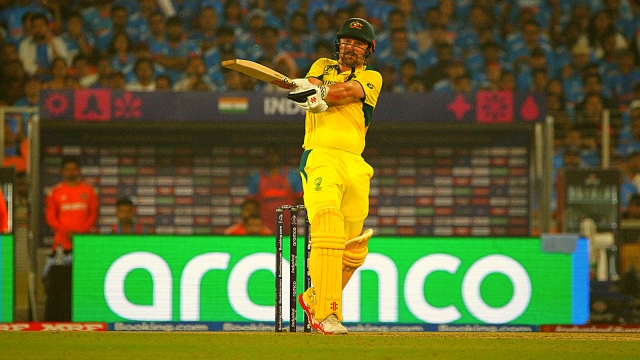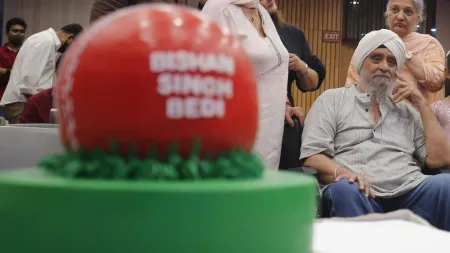- India
- International
World Cup: How Travis Head worked on his technique to become Australia’s headline-maker in an incredible 2023
His World Cup heroics, after coming into the team following injury, are the culmination of a glorious year, which included a hundred in the World Test Championship final.
 Travis Head bats in the World Cup final against India at the Narendra Modi Stadium in Ahmedabad. Express photo by Nirmal Harindran
Travis Head bats in the World Cup final against India at the Narendra Modi Stadium in Ahmedabad. Express photo by Nirmal Harindran Pads on, a sheepish smile spread over his content face. Travis Head serenaded onto the pitch when Glenn Maxwell thumped the winning runs to secure Australia’s sixth ODI World Cup title. He sank onto the ground, kissed the grass and then walked as though he was in a state of intoxication, embracing anyone who came in his path to congratulate him, leaping into the folklore of Australian cricket.
It’s the culmination of a glorious year, one where he scored a hundred in both finals of Australia this year, one wherein he has defined Australian cricket in his image. Both in the World Test Championship and World Cup finals, he turned out to be India’s bogeyman.
Both times, he was an unusual suspect. At the WTC final, his short-ball vulnerability was pitted for failures. He hammered a hundred of unalloyed joie de vivre to seize the moment. In the final, he racked up a hundred that assimilated both fire and finesse.
The glory seemed distant when the World Cup began.
A fortnight before the World Cup began, he broke his left hand during a warm-up game against South Africa, hit by seamer Gerald Coetzee. He thought his dream was over. “When it first happened I thought my chances were done. I went through a range of emotions through those three or four days early on, to think that I sort of missed a chance,” he would admit to the media upon his return.
He was such a valuable player that the selectors chose to keep his name in the squad while sending him home to see how quickly he could recover while avoiding surgery. “Fortunately, it healed very fast,” said Head, even though he had to keep his hand in a splint for nearly a month.

When he picked the bat again, he did not feel the power. He felt weak, but then he thought. “I don’t hit massive sixes anyway, so maybe I’ve just got to keep it on the carpet a little bit more.”
Follow all the action from the Cricket World Cup 2023 on our special World Cup section. You can also find the latest stats, like the top scorer and the highest wicket-taker of the current edition, upcoming World Cup fixtures and the points table on the site.
In an indirect way, he was explaining the essence of his own batting. He is an attacker, but not one reliant on blind power. He is more of glides and deflections, punches and slashes. The soul of his batting, he once said, is, “how I line the ball up, where I line the ball up and where I’m trying to play it. I am instincts player.”
It’s a technique he honed while playing with his father Simon at the Tea Tree Gully CC in Gawler, a quaint town in South Australia. Even before he turned five, he was tagging along with his father and brother Ryan, a fast bowler whose career was thwarted by injuries before he ventured into the hospitality industry. “The boundaries were short, there was not much swing, or bounce, and that probably shaped my technique,” he would say.
It was then honed by former coach Justin Langer and South Australia’s General Manager of High Performance Tim Nielsen.
The biggest flaw was his too side-on stance. “As a left-hander, that can be a real curse because you’ve got the blind spot when they bowl short at you, and also it just takes your weight over a little bit. And his bat was coming back almost to middle and leg stump,” former coach Justin Langer told cricket.com.au.
Langer, in turn, detailed the problem to Nielsen, who detected that the real problem was how he was picking and holding the bat. “The bat was pointing almost straight back over the middle stump in his stance, rather than him being a bit more relaxed with his bottom hand. Then, because of the way he naturally cocks his right wrist, the bat almost flays out or opens out a bit towards first slip,” he said.
But neither attempted to curb his carefree impulses. The mind is what makes his batting work. His biggest gift is that he throws the punches straightaway. There is no weighing in of the situation. The first ball he faced, off Jasprit Bumrah, swung away massively. He did not flinch. The next ball, fuller outside the off-stump, he merely flapped his hands at it. The ball screamed to the fence. The stroke debunked conventions and logic. He could have waited for the spell to pass by; he could have bided his time and then attacked. But that’s not in his skin. A dot ball later, he blitzed Bumrah through cover, a stroke of bottom-handed brutality.
As wickets fell and Australia plunged to 47 for 3, he embraced a lull. He scored just two runs in 19 balls, but he smacked Mohammed Shami for back-to-back fours. The first was a back-cut, more of a back slap, that he created from nowhere. There was no width, the ball seemed too close to cut. But he just arched his body a fraction, sank his knee a bit and hacked it behind with his wondrously dexterous hands.
Choosing the moments
He would similarly choose moments to fling knockout blows. He knew the threat of Kuldeep Yadav, so he heaved him over mid-wicket. Later, when Bumrah was reintroduced to conjure magic and break his obdurate stand with Marnus Labuschagne, he crunched three fours in five balls. It was the precise moment India lost their hope. First he shoveled the Indian seam king through mid-wicket, before he thundered him down the ground. Bumrah went short and was pulled mercilessly. He made Bumrah bowl full because he conveyed the impression that they are not bowling full enough. The length keeps getting fuller and fuller, and he punished them with the raspy flicks.
He, thus, is someone who plays the strokes that his technique allows him to. His front-foot stride is not too long; he does not look to bring the bat down straight because his hands are further from his body and he has less control when he does that. So he waits patiently on the back-foot, for the bowler to reach him. But for a back-foot dominant batsman he is not much of a puller. Short balls are his supposed weakness. But still he finds a way through.
The unconventional methods are perhaps what made critics doubt about the longevity of his success. He does not breathe assurance or stability. Even when he is on a hundred, he could look shaky. But his overwhelming success in the last two years in Tests and ODI cannot be a mere fluke. Since his comeback last year, he averages 57 in 16 games, made Australia’s top-order dynamic, liberated David Warner, provided an extra bowling option for his captain. In Australian cricket, this has been the year of Head, the chief architect of their two ICC titles this year. And it’s time his critics accepted that it’s the way he bats and it has been resoundingly successful.









































